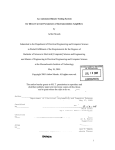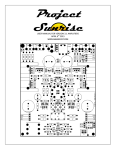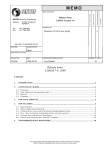Download IOPoint-PL User`s Manual 2006-03-31A
Transcript
IOPoint-PL User’s Manual 2006-03-31A © 2006 Bibaja Landscape Automation, LLC INTRODUCTION 1 12 CONFIGURABLE I/O PINS 3 NETWORK ACTIVITY INDICATOR OUTPUTS DOCUMENT ORGANIZATION 1 1 1 IOPOINT-PL HARDWARE 2 OPERATING SPECIFICATIONS PCB LAYOUT IOPOINT-PL MODULE PINOUT IO0-IO11 RESET_ SERVICE_ VDD5 GND VA RXIN (COUPLING CIRCUIT INTERFACE) PKD (RX) BIU TXON (TX) 2 2 3 3 4 4 5 5 5 6 6 6 6 POWER SUPPLIES AND COUPLING CIRCUITS 7 IOPOINT-PL COUPLING COMPONENTS RX COMPENSATION INDUCTOR (L3) DC BLOCKING CAPACITOR (C7) PROTECTION CLAMP DIODES (D3 AND D4) TAMURA WALL PLUG SUPPLY AND COUPLING CIRCUIT NON-ISOLATED 24 VOLT AC SUPPLY AND COUPLING CIRCUIT Bibaja Landscape Automation, LLC i 7 7 7 7 8 10 © 2006 INTRODUCTION The IOPoint-PL is a programmable module with 12 I/O pins, 3 network activity indicator pins, and embedded power line communications. With the addition of a simple coupling circuit, power supply, and your I/O circuitry, you will have a complete, remotely controllable device ideal for home, industrial, or building automation. 12 Configurable I/O Pins Each IOPoint-PL module includes 12 configurable I/O pins. All of these pins are capable of performing simple digital input and output functions. Other pins have timer/counter functions useful for implementing a variety of input and output I/O models. For a complete list of available pin functions, see the PL3120-E4T10 Smart Transceiver User’s Guide available from Echelon’s website at www.echelon.com. 3 Network Activity Indicator Outputs Transmit (TX), Receive (RX), and Band In Use (BIU) network activity indicator outputs are included on the IOPoint-PL module. These outputs provide feedback for network activity, when a particular IOPoint-PL responds to a message, and if there is noise on the network that may impair performance. See the detailed pin descriptions in the IOPointPL Hardware section of this document. Document Organization This document is organized into three major sections: 1) Introduction – This section you are reading now is meant to give an overview of the IOPointPL module features as well as explaining the different sections of the User’s Manual. 2) IOPoint-PL Hardware Specifies the voltage and current ratings for the device. The PCB footprint is given here (the same as in the datasheet). Detailed pin descriptions and functions are listed. For complete pin descriptions of the 12 configurable I/O pins, you will need to refer to the PL3120-E4T10 Smart Transceiver User’s Guide on Echelon’s website at www.echelon.com. 3) Power Supplies and Coupling Circuits This section presents a quick overview of how to build various power supplies and coupling circuits for the IOPoint-PL module to get your signals on and off the AC power mains. Users who are curious about learning how to design a variant of these power supplies and coupling circuits should carefully read the PL3120-E4T10 Smart Transceiver User’s Guide. Bibaja Landscape Automation, LLC 1 ©2006 IOPOINT-PL HARDWARE Operating Specifications Parameter VA VDD5 IDD5 IA(rx) IA(tx) Temp Description Analog Supply Digital Supply Voltage Digital Supply Current Analog Supply Current, Receive Analog Supply Current, Receive Operating Temperature Min 10.8 Typ 12 Max 18 Units V 4.75 5.0 5.25 V --- 10 (depends on your I/O) ma --- 350 500 ua --- 120 250 ma -20 25 85 C PCB Layout The following diagram shows the PCB layout required for mounting the IOPoint-PL module in your design: 2.40 1.60 1.45 17 18 0.95 P1 Layout for IOPoint Module Mounting 1.60 6 0.40 1 2 P2 0.15 1 0.10 0 0 0.15 Reference 3 Mounting Holes P1, P2 Dimensions are in inches. 2.15 2.25 Pad O.D. 0.285 0.060 Bibaja Landscape Automation, LLC Plated Hole Diameter 0.152 0.040 2 ©2006 For prototyping convenience, the pins of the IOPoint-PL are laid out on a 0.1inch grid. Standard perforated prototype PCBs may be used to mock up early designs before building custom PCBs. IOPoint-PL Module Assignments IOPoint-PL Module pin assignments for headers P1 and P2: Name P1 Pin # P1 Pin # Name IO8 17 18 SERVICE_ IO7 15 16 IO10 IO6 13 14 IO9 IO5 11 12 VDD5 RESET_ 9 10 IO4 GND 7 8 IO3 GND 5 6 IO2 GND 3 4 IO1 IO11 1 2 IO0 Name RXIN VA PKD BIU TXON GND P2 Pin # 6 5 4 3 2 1 The pin functions are described in detail in the following paragraphs. IO0-IO11 IO0 through IO11 are the 12 configurable digital I/O pins. These pins map directly to the pin on the PL3120-E4T10 Smart Transceiver chip on the IOPoint-PL module. Pins IO0-IO3 have high current sink capability (20ma sink, 1.4ma source). Pins IO4-IO7 and IO11 have configurable pull-ups. Pins IO0-IO1 may be used as timer/counter output pins. Pins IO4-IO7 may be used as timer/counter input pins. Pins IO8 and IO10 may be used with the embedded hardware UART (serial communications interface or SCI). Pins IO7-IO10 may be used with the embedded hardware SPI (serial peripheral interface, basically a synchronous shift register with clock, data in, and data out). Detailed descriptions for each pin’s capability may be found in the Powerline Smart Transceiver Databook available on Echelon’s website (www.echelon.com). Bibaja Landscape Automation, LLC 3 ©2006 RESET_ RESET_ is a bidirectional open-collector pin. At power up, the PL3120-E4T10 microcontroller on the IOPoint-PL module will drive RESET_ low. External circuitry may use this active low signal to initialize any state dependant logic. An internal pull-up will bring the RESET_ signal high. If required, an external pushbutton may be attached to the RESET_ signal to restart the IOPoint-PL module application and any external circuitry. Appropriate ESD protection should be provided to prevent glitches and impulses on the RESET_ line. Any negative glitches will cause the IOPoint-PL module to reset and restart the application. This behavior may be undesirable in a light controller, for example, where the lights would turn off from an electrostatic discharge near the reset button. NOTE: Never drive the RESET_ signal high. Doing this may prevent the microcontroller on the IOPoint-PL module from resetting itself. This may lead to corrupted EEPROM memory in the IOPoint-PL caused by errant code execution. SERVICE_ SERVICE_ is an active low bidirectional signal that indicates device status as an output and can trigger the IOPoint-PL module to send a 6-byte unique ID (called a Neuron ID) on the power line network as an input. This signal constantly toggles between an input and an output at a 76Hz rate. The following diagram shows a schematic of the typical connection to the SERVICE_ signal: VDD5 R LED SERVICE_ Service Button The light emitting diode (LED) is a status indicator when the SERVICE_ signal is an output. The way the LED blinks will tell you the state of the IOPoint-PL module: • • Blinks once at power-up then stays off means an application is loaded, configured, and running Blinks once at power-up then blinks on and off at about a 1Hz rate means an application is loaded, but the device is unconfigured (no subnet/node address or Bibaja Landscape Automation, LLC 4 ©2006 • domain information has been programmed for the power line interface). The application may or may not run depending on compile time options (a pragma which will make the application run when unconfigured.) Blinks once at power-up then turns on and stays on means the IOPoint-PL is applicationless. The device is waiting for an application to be loaded from the power line network. When the service pin is an input, it will detect the state of the service button. When the service button is pressed, a low level will be read on the SERVICE_ input. This low level input will cause the IOPoint-PL module to transmit a unique 6-byte ID on the power line network. This 6-byte ID is how the network interface is able to communicate with and configure new devices. The typical installation scenario for a power line network is: 1) 2) 3) 4) Wire up new device and apply power Prepare computer to install new device by entering install mode Press the service button on the new device Confirm the computer has received the unique ID message and complete the installation. The computer will be running some sort of network management application to configure new devices on the network. Echelon offers LonMaker for Windows and the LNS Network Operating System for configuring and installing new devices. VDD5 VDD5 is the digital 5 volt power input. An external regulator is required to produce a clean noise free 5-volt power supply for the IOPoint-PL module. If you intend to use the IOPoint-PL in a system with other digital logic that may produce a lot of noise, you may wish to consider providing an isolated 5-volt supply for the IOPoint-PL module. Too much digital switching noise will reduce your receive performance by about 12dB. This could easily be the difference between a working or non-working system. Be sure to always check your receive attenuation tolerance carefully as per the Smart Transceiver User’s Guide verification checklist. GND GND is the IOPoint-PL module ground. A total of 4 ground pins are provided on the IOPoint-PL. In addition, the 3 mounting points for the module are also tied to ground. We recommend using ½” metal standoffs and ¼” #6-32 screws to mount the module to your PCB. This will provide good solid grounding for the IOPoint-PL module. VA VA is the analog supply voltage. This voltage is used to supply the transmit amplifier and the transmit voltage monitoring circuit. If power management is enabled (for energy storage power supplies), the IOPoint-PL module will stop any transmission in progress and wait for the VA supply to recharge up to around 12 volts. An external capacitor of at least 120uF (1500uF for a wall-plug supply) is required. See the chapter on power supplies and coupling circuits for more details and the Smart Transceiver User’s Guide. Bibaja Landscape Automation, LLC 5 ©2006 RXIN (Coupling Circuit Interface) RXIN is the TX/RX signal path between the power line transceiver and the coupling circuit. Part of the coupling circuit is integrated on the IOPoint-PL module for your convenience. You must provide the remainder of the circuit on your application electronics PCB. See the chapter on power supplies and coupling circuits for more details. PKD (RX) PKD (packet detect) indicates when a packet receive (RX) is in progress. This pin is active high, driven to 5 volts, and may be used to drive an LED for monitoring activity on the power line network. No pulse stretching is required since the majority of packets on the power line network are in the 40ms range and are easily seen on the LED. BIU BIU (band in use) indicates a tone is present on the power line network. BIU is active high, driven to 5 volts when a tone is present on the power line network above a certain threshold. This signal may be used to drive an LED for monitoring signals present on the power line network. In Europe, BIU is used to share the power line between different power line carrier devices. For the European sharing feature to work, the CENELEC access protocol must be enabled by configuring the transceiver parameters to be PL-20C. By default, the IOPoint-PL module ships with PL-20N parameters (N stands for no protocol, C stands for CENELEC protocol.) The transceiver parameters may be changed using the NodeLoad application available from the downloads section of Echelon’s website. In addition to the power line sharing function, BIU is also a useful indicator of in-band noise on the power line. The LED will blink when in-band noise is present. High levels of noise may prevent proper communications on the power line network. Filtering on noisy devices may sometimes be required for reliable communications. TXON (TX) TXON, transmitter on, indicates a packet transmit (TX) is in progress. This active high 5-volt signal may be used to drive an LED for monitoring network activity. Each time the SERVICE_ signal is driven low, there will be one pulse on the TXON signal to indicate the unique ID message was transmitted. When combined with the PKD (RX) indicator, the TXON (TX) indicator will help you to clearly see communications occurring with a particular IOPoint-PL module. Bibaja Landscape Automation, LLC 6 ©2006 POWER SUPPLIES AND COUPLING CIRCUITS Proper design of power supplies and coupling circuits for use with the IOPoint-PL module are critical for achieving full communications performance. We recommend thoroughly reading the PL 3120/ PL 3150 Power Line Smart Transceiver Data Book from Echelon (www.echelon.com) for full details. Chapter 5 discusses power supply selection in great detail, and chapter 4 talks about different coupling circuits. These sections are a MUST READ if you are to succeed in designing a reliable power line communications device. This chapter presents a brief overview of what coupling components are already included on the IOPoint-PL module. Two example power supply/coupling circuit combinations are presented to show how you may use the IOPoint-PL in your system. IOPoint-PL Coupling Components There are 4 coupling components included on each IOPoint-PL module. These coupling components correspond to L3, D1, D2, and C2 in Echelon’s PL 3120/PL 3150 Power Line Smart Transceiver Data Book. RX Compensation Inductor (L3) For the receive circuitry, the RX compensation inductor (L3 in Echelon’s data book) is provided. Make certain no other inductors are placed near this inductor. If two inductors are laid in parallel, the signal from one may couple into the other. If your design requires another inductor to be placed close to IOPoint-PL inductor L3, then make certain your inductor is oriented orthogonally to L3 to minimize coupling. Coupling from power supply inductors may impair receive performance and may inject noise back on to the power line causing conducted emissions violating FCC and CENELEC regulations. DC Blocking Capacitor (C7) A DC blocking capacitor is provided on each IOPoint-PL module. This capacitor corresponds to C2 in Echelon’s data book. The transmitter circuit is biased at about ½ of the VA supply. This capacitor prevents shorting the transmitter bias voltage to the potential of the remainder of the coupling circuit. Protection Clamp Diodes (D3 and D4) Protection clamp diodes D3 and D4 are included to protect the transmit and receive circuits from large impulses that may get through the power supply and coupling circuitry. The power supply should provide adequate protection in the form of a varistor, transient voltage suppressor, or gas discharge tube. These clamp diodes act as the last line of defense and are design to react very quickly to short transients on the line that may get past slower protection circuits. These diodes correspond to D1 and D2 in Echelon’s data book. Bibaja Landscape Automation, LLC 7 ©2006 Tamura Wall Plug Supply and Coupling Circuit One of the simplest and most convenient coupling circuits uses the Tamura wall plug supply with integrated coupling transformer. Various voltages and plug styles are available from Tamura. L106 VA D103 IOPoint-PL C103 DC Receptacle & Plug (Center Positive) GND L102 RXIN Tamura Wall-Plug Supply & Coupling Four components plus a DC power receptacle are all that are required to complete the connection from the IOPoint-PL to the power line network. The following table gives the required values for these components: Part Value Requirement D103 16V Zener +5%, 5W, Zener Diode C103 >1500uF L106 1mH L102 Bead DC Receptacle +20%, >25VDC, aluminum electrolytic, < 0.3 ohm ESR @ 100kHz +15%, Imax >390mA, RDC<2.3ohms <0.5ohms@100kHz,>20ohms @10MHz, Imax > 2amps 2.1mm Power Jack Example Manufacturer Part # ON Semiconductor 1N5353B Panasonic-ECG EEU-FC1E152 Delevan 2474-37L Steward HI1206P121R-00 CUI Inc. PJ-202A At the time of this writing, all of these components are readily available through online parts distributors such as Digikey (www.digikey.com) and Mouser (www.mouser.com). Design of the VDD5 (5 volt) supply depends on how much current your circuitry will require. For circuits requiring less than 80ma, one 78L05A and a capacitor are all that are required to regulate the VA supply to make VDD5. Bibaja Landscape Automation, LLC 8 ©2006 For circuits requiring between 80ma and 250ma, a 78M05 and a capacitor are required. The remaining 150ma is reserved for transmit power. For large volume orders of the supply, contact Tamura: Tamura Corporation Industrial Device B.U. Telephone: +81-492-84-5721 (Japan) +1-800-472-6624 (USA) Fax: +81-492-84-9106 www.tamuracorp.com Two of the device types available from Tamura are: 120VAC, 60Hz, 12VDC 230VAC, 50Hz, 12VDC 425A12400P 425F12400P Tamura Supplies are also available on Bibaja’s online cart at http://www.bibaja.com/cart. Bibaja Landscape Automation, LLC 9 ©2006 Non-Isolated 24 volt AC Supply and Coupling Circuit This simple non-isolated 24 volt AC supply and coupling circuit is low cost and operates on voltages ranging from 18 to 28 volts AC. If required, Bibaja’s PLC240 device may be used to couple signals from the 24 volt AC supply to the 120 or 240 volt AC mains circuits. L106 U101 VA D101 LINE R101 C103 C104 C102 R102 IOPoint-PL NEUTRAL GND L101 RXIN C101 Part Value Requirement C103 >1500uF R101 240ohms +20%, >25VDC, aluminum electrolytic, < 0.3 ohm ESR @ 100kHz +1%, 1/10watt R102 2.61Kohms +1%, 1/10watt U101 LM317A C104 >120uF D101 1N4935 C102 0.1uF L106 1mH L101 1mH C101 0.47uF Linear regulator, 1.5A, TO220 or 3PFM package (important for heat dissipation) +20%,>50VDC aluminum electrolytic 1A, fast recovery rectifier diode >50V, X7R, +20% Example Manufacturer Part # Panasonic-ECG EEU-FC1E152 Yageo America 9C08052A2400FKHFT Yageo America 9C08052A2611FKHFT Texas Instruments LM317KTER (3PFM) or LM317KCS (TO220) Panasonic ECG EEU-FC1H121L Diodes Inc. 1N4935-T Kemet C0805C104M5RACTU +15%, Imax >390mA, Delevan RDC<2.3ohms 2474-37L +10%, Imax >30mA, Taiyo Yuden RDC<14ohms LAL04TB102K +5%, >50VDC, stacked metal Panasonic ECG film ECQ-V1H474JL Bibaja Landscape Automation, LLC 10 ©2006




























